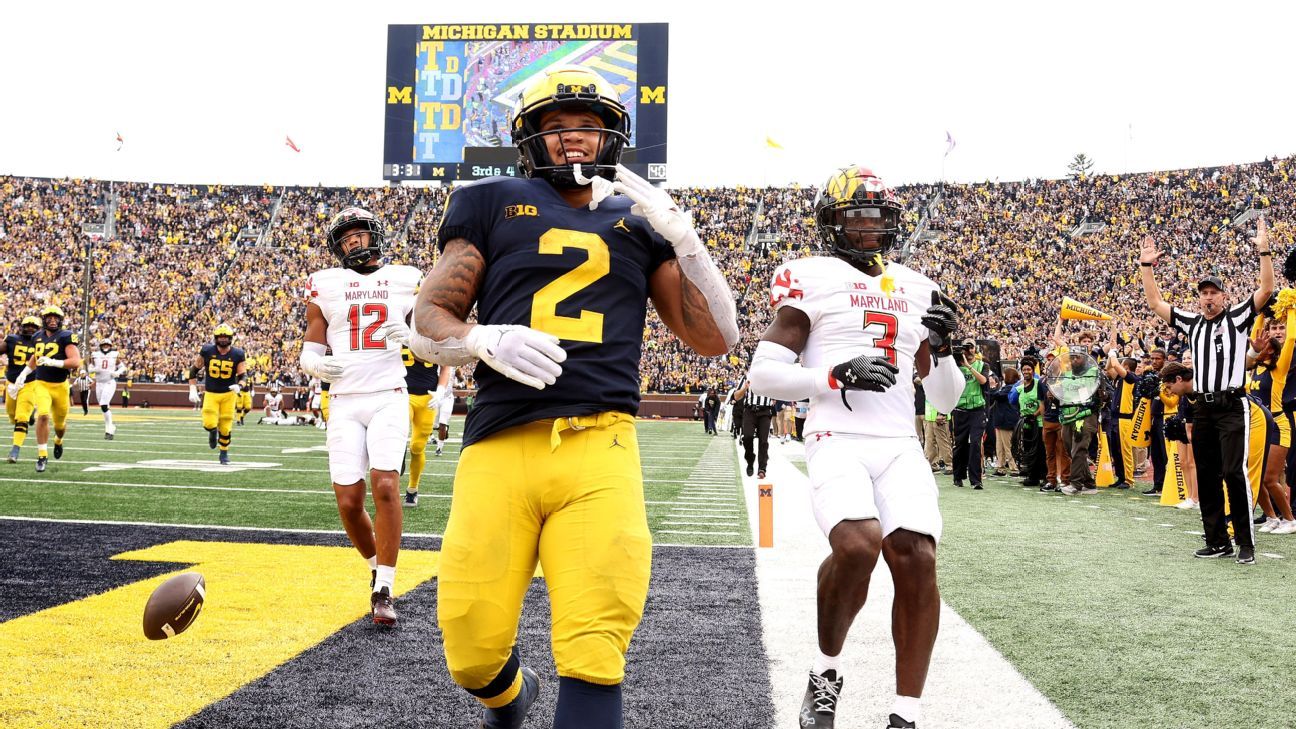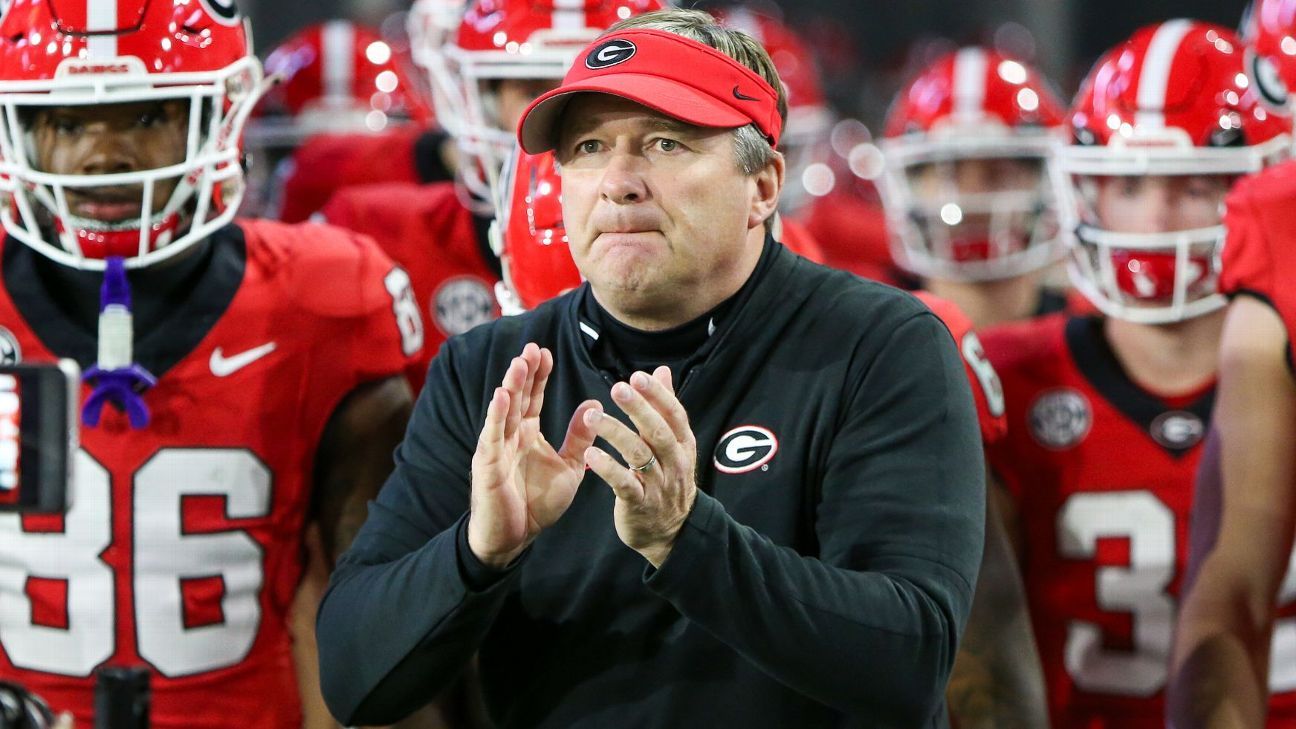
ANN ARBOR, Mich. — When

1 Related
Corum has had a dream season for 10-0 Michigan. He’s tied for the national lead in touchdowns (18), leads the FBS in first downs (81) and ranks third in rushing yards (1,349) despite logging only four total carries in the second halves of Michigan’s first three games. He accounts for 26% of Michigan’s plays of 20 yards or longer and averages 5.8 yards per carry in Big Ten play. The 5-foot-8, 210-pound Corum has become the top non-quarterback candidate in a crowded Heisman field.
Last week, Michigan coach Jim Harbaugh called Corum the best college running back he ever coached and the second best ever behind future Hall of Famer Frank Gore. Others around the program describe a uniquely impactful player who combines attributes from some of the game’s all-time great runners, and an unabated will to work.
“A generational back,” said Michigan associate head coach Biff Poggi, who coached Corum at Baltimore’s St. Frances Academy and was just named the new head coach of the Charlotte 49ers. “You coach your whole life and probably will never have a guy like this.”
Corum plays in the nation’s largest stadium at Michigan, and his football journey took him to the urban epicenter of Baltimore. But his roots are firmly in Marshall, a speck on the map with a population of 2,913, according to the 2020 census. The town has a Food Lion and a 7-Eleven, where the old heads hang out and talk. There’s a library, several churches and plenty of one-way streets.
“Everyone knows everyone,” Corum said.
His parents both grew up there. The family lived in several spots, including farms managed by Christina’s father, David Pierce. In 2005, while the Corums waited for their home to be built, they stayed with Pierce on the horse farm owned by Cooke.
Blake adored “the red house,” Pierce’s home on the property. He even has it tattooed on his arm.
“This kid probably was in middle school and he was like, ‘I’m going to buy that farm, mom,'” said Christina Corum, who grew up on the farm. “There are certain things he’s dreamed of that motivate him and keep him going. His great memories, a lot of them are from the farm. He would go outside and jump on a mower. He loved looking for frogs down by the creek.”
“A country guy for sure,” Blake said.
The oldest of four — Blake has sisters Skye, Starr and Rainn — he spent his childhood exploring.
“He always ran around with no shirt on, no shoes,” James said. “You’ve got to build tough feet in the country, man. You walk on gravel, in the woods, whatever.”
James noticed Blake’s physical gifts early. He walked before 1 and rode a bike without training wheels at 3. He started playing football at 5, and soon averaged five touchdowns per game.
Blake began working out before school in fifth grade. James took him to train with local high school players and their strength coach. Blake also had several private coaches.
“From fifth grade to eighth grade, I was consistent,” Blake said. “My parents made me show them what I really wanted … before they put in the sacrifice.”
When Blake reached high school, the family faced a decision. Fauquier High, where James played running back and cornerback, was no longer the county’s only high school. The team had slipped (Fauquier went winless this season). The area also had not produced many NFL players other than Cleveland Browns offensive lineman Wyatt Teller, from Bealeton.
Neighboring Maryland offered better competition and visibility for colleges. Schools had scouted Corum and wanted him. He chose St. Vincent Pallotti in Laurel, about 75 miles from Marshall.
“We didn’t even think twice about it,” Christina said. “We didn’t doubt his ability to work hard. If that’s where he felt he needed to be, then we’re going to support that. Now I’m not going to lie: It was taxing on the family.”
The drive took two hours each way. Christina usually did drop-offs, returning home in time to take her daughters to school. James handled pickups but sometimes would do both legs. He owns a landscaping business, which allowed him to work flexible hours and pick up his kids.
But the trips took a toll.
“Dreadful,” James said, laughing. “Damn, you’re tired all day. You’re like, ‘I’ve got to travel this [Capital] Beltway, I’m sitting in traffic both ways.’ There were days I didn’t want to do it, but we did.”
Blake woke up between 3 to 4 a.m. on school days. Twice a week, he stopped for workouts in Manassas, Virginia. He arrived at Pallotti around 6 a.m. Corum got to know the custodians, and would crash on a couch until the school bell rang.
After practice, he’d head home.
“We’d ride in the HOV lane, but it still took us two hours,” Blake said. “I’d get home at 7, 7:30, eat dinner, do homework, take a shower, sleep and repeat. It was like that for two years.”
The work resulted in FBS scholarship offers, including one from then-Indiana assistant Mike Hart, the all-time leading rusher at Michigan. But before making a college choice, Corum wanted to upgrade his high school competition.
Poggi, who had built St. Frances into a national power, initially wasn’t interested. He liked bigger backs. When Ian Thomas, a former Illinois linebacker who coached Pallotti High and had joined Poggi’s staff, brought Corum over, Poggi saw a more filled-out player than he expected.
Still, he told Corum that St. Frances had plenty of running backs who fit better than he did.
“I said, ‘What do you think about that?'” Poggi said. “He said, ‘I’ll beat everybody out, and I’m coming to win the national championship.’ I said, ‘OK, you’ve got a scholarship.’ The rest was history.”
Corum’s first high school was two hours from home. St. Frances, located in the heart of Baltimore, was a world away from tiny Marshall.
“My first day there, I saw someone get shot,” Corum said. “I’m going from peaceful living, y’all don’t get bothered in Marshall. It was a big change, but one of the best experiences I had.”
Blake felt he matured at St. Frances, where he began boarding (players live in Canton, a neighborhood near Baltimore’s harbor). He also saw how the city embraced the program.
In 2019, St. Frances opened against Miami Central, a game televised by ESPN. Corum had 155 rushing yards and four touchdowns in a 49-13 win. After practice the next week, Corum was walking down Chase Street, which bisects the school and the jail.
“The inmates are shouting down, ‘We just watched you, keep doing what you’re doing, we’re proud of you,'” Corum said. “I’m looking up, I can’t see them, but they can see out their little window.”
Corum had a different background than many of the St. Frances players, but quickly bonded with them. After games, he’d often drive a group back to Marshall for the weekend.
Some of his teammates had never seen cows or ridden four-wheelers or fished.
“I told Blake, ‘You’re learning from them and they’re learning from you,'” Christina Corum said. “He created some great friendships. He changed a lot; they changed a lot.”
Corum quickly became a team leader. St. Frances had a roster filled with elite players, but none trained quite like he did.
“It was a little annoying because he was always working out,” Poggi said. “I would say, ‘Look, you’re going to carry the ball 35 times Friday night. Can you not go in the gym Saturday morning, Sunday morning?'”
Corum’s talent and drive helped him become a top-125 recruit. His college decision came down to Michigan and Ohio State. Corum visited each school on back-to-back June weekends in 2019. The Ohio State visit went well, and Christina and James expected their son to become a Buckeye.
But on the last day at Michigan, Blake came to his parents’ hotel at 7 a.m. He said he had called Ohio State to tell them he was committing … to Michigan.
“Blake’s always been the kind of kid to help a team get back to where they were,” James said. “He’s never been one to jump on the bandwagon.”
Mike Hart doesn’t hold back in assessing Corum: “One of the best backs to ever play here.”
The view of Corum inside Schembechler Hall seems more suited for a four-year starter like Hart, or a Big Ten MVP like Harbaugh. Corum only had 26 carries as a freshman, as Michigan went 2-4 during the COVID-shortened 2020 season. He struggled to absorb the playbook and to identify blitzing defenders.
Corum needed to refine his mental approach before his physical talent could take over.
“Coach Hart changed the game for me,” Corum said. “Last year, my IQ got better. Before the play, I knew who was [blitzing], my mind wasn’t racing, I knew the plays, I was confident.”
Hart, who returned to Michigan before the 2021 season to coach running backs, had followed Corum throughout his high school career. He saw a talented runner who needed to, of all things, slow down.
“Slow down when you’re working out all the time, slow down when you’re carrying the ball, faster isn’t always better,” Hart said. “If you listen, which he does, then you get better. That’s what he’s done. Some people like to work hard, but people don’t work like Blake works.”
During Corum’s freshman year, heavy snowfall canceled classes and left the streets and sidewalks deserted. Rather than stay inside, Corum and Michigan linebacker Nikhai Green-Hill, his roommate and teammate at St. Frances, drove to Veterans Park in Ann Arbor, where they ran the steepest hill they could find.
Afterward, they defrosted in Green-Hill’s car.
“It was one of those vulnerable moments, where you’re like, ‘This is what we’re working toward,'” Hill-Green said. “Some people call it manifestation, or believing in yourself. He’s told me everything he’s wanted to do, his dreams and aspirations, and he’s checking the boxes. That’s just a testament to him and how hard he works.”
Last season, Corum became the lightning to Hassan Haskins‘ thunder, finishing behind Haskins in carries (270-143), rushing yards (1,327-952) and touchdowns (20-11). But Corum had a similar carries load until being injured on his first rush against Indiana in Week 10, and essentially missed three games. He averaged nearly 2 yards per carry more than Haskins (6.7-4.9).
With Haskins gone to the NFL, Michigan is now seeing the complete, best version of Corum. Hart can’t present a film cutup in running back meetings that Corum hasn’t already reviewed. Corum understands blocking schemes and teammates’ assignments, and even changes protections.
Hart, who finished with 5,040 yards on 1,015 carries with 41 rushing touchdowns at Michigan, sees a lot of himself in Corum. Hart just played longer.
“We’re really similar, he’s just faster,” said Hart, who had a team-record 28 100-yard rushing performances. “I always tell him I’m a better short-yardage back. But he’s awesome. Everything you want in a back is Blake Corum. When the [NFL] scouts ask me about him, there’s no red marks on the kid at all.”
Harbaugh has compared Corum to a chess player always thinking several moves ahead. Corum relies on small, seemingly subtle moves to find room. He ranks sixth in missed tackles forced (64).
“That is just a natural instinct,” Corum said. “You can work on cuts all day, you can work on new moves all day, but if you can’t do it in the blink of an eye, it doesn’t matter. Before the play, I’m not thinking, ‘I’m going to hit him with the spin move, or I’m going to ‘jurdle’ him.'”
“Jurdle,” as in the Madden move?
“A jump-hurdle,” Corum explained. “It’s a sudden light jump stiff-arm hurdle, trying to just get your leg out the way. I do the jurdle quite often.”
When Poggi studies Corum, he sees shades of two of the game’s greats, Walter Payton and Barry Sanders. Corum, playing at 10 pounds heavier than last season, has a compact frame and runs with power, like Payton.
He also can confuse defenders like Sanders, who is tracking the Michigan star.
“He’s all wrapped into one,” Poggi said. “Those guys just don’t come around very often.”
Bilal Saeed tries not to text Corum often. He’s respectful of Corum’s time, especially during a season like this.
There’s only one issue: Corum keeps blowing up Saeed’s phone.
“Blake is hitting me up: ‘What about this idea for the turkey giveaway? I want to do this.’ Let’s do a backpack giveaway,'” said Saeed, who helps organize community events in and around Ann Arbor. “He’s come in with all these ideas, based on what he sees.”
Saeed first met Corum in June 2021 at the launch of CLR Academy, an outreach program for kids in low-income areas in Ypsilanti, which borders Ann Arbor. Saeed, who has known Hart for years and worked on events for Hart’s foundation, asked if any Michigan players would come to the first CLR event, held at the Sycamore Meadows apartments.
Corum came with Hill-Green and several others.
“Right away, [Corum] starts reading books with the kids, building these connections,” Saeed said. “Then, he kept showing up. He was hooping with the kids, kicking the soccer ball around.”
Corum has always been a giver. As a kid, he’d bring his own money to church and deposit bills in the offering plate. At St. Frances, he took on a job and gave some of his wages to people on the street.
But the arrival of name, image and likeness opportunities provided the platform for Corum to truly give back. Corum has used his NIL earnings to fund several initiatives, including school supplies, meals and holiday gifts. In November 2021, he held “Giving Back 2 Give Thanks,” an event where he passed out 100 turkey meals for families in Ypsilanti, alongside his father and Hill-Green.
They’ll do the same thing Sunday, except with at least 300 meals and backpacks.
“It was always inside of Blake,” Saeed said. “Just having that intention, the impact isn’t going to only be the community he’s reaching out to, but the next generation of athletes. We’re talking about a Heisman candidate here, and all you can see in this guy is his humility.”
Saturday could mark Corum’s final game at Michigan Stadium. He’s not projected high in the NFL draft — only one of ESPN’s experts pegged Corum among the top five draft-eligible backs — but his success, position and age make a move likely.
Corum thinks about his legacy at Michigan. He has football goals left, including the Heisman. For some time, Poggi has playfully bumped Corum and said, “Let’s go to New York.” Strong performances Saturday against Illinois, the nation’s No. 2 defense behind Michigan’s, and most certainly next week at Ohio State, will help secure a finalist spot.
But Corum wants to be remembered more for how he impacted people on campus and in the community. Seeing Halloween pictures of kids dressed in his jersey “meant a lot.”
So many of the dreams he once had, in the peaceful stillness of Marshall, have come true at Michigan. And more will come.
“I try to remind myself how blessed I am,” Corum said. “So I dream every day. I don’t stop dreaming.”












